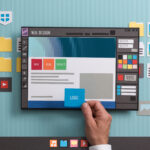How to manage a design project? Learn from a first timer

Managing a design project : The major challenges
They say there is a first time for everything, if three years back someone had told me that one day I’ll be managing a project, I would have rolled on the floor laughing. I was farther up from managing a project just as Pluto from the Sun. Yet after three years I was told: ‘Ok Dude, this design project you handle’, and I shook my head in agreement as if it is not a big deal at all.
The project reminded me of the story of three blind men trying to figure out an elephant. I knew vaguely what the end product will be, yet in the beginning I could not figure if I was looking at the tail, or the trunk, or something else. However, there is a wonderful tool called perseverance.
It is a bit hard to understand it, hence in the movies they use simpler phrases like – ‘never let go’ and ‘hold strong’. My teammate and me held on strong like barnacles on the side of a boat. Through all the rough weather emerged a nice IA, then the client rejected it. We made one more; rejected. We had to ‘holdstrong’.
Learning 101: Importance of Communication
We vented our frustrations to the client while they vented back that their boss wasn’t convinced. This taught us how important communication is in our business. You see, the boss did not talk to us directly, but in the end, it is him (or her) who approves of our ideas, and he had thoughts about how it should span out. Had we not taken his silence as signs of inaction and instead prodded him to know what his views were, we’d have saved two precious weeks.
Those two weeks made us go over and over the plan of the new website and we realised that was a good thing. You could wake me up in the middle of the night to ask me the entrees in the profile and I’d have listed out all the 9 things with individual details. The knowledge specifically helped when we had to create project timelines. When we were asked to create a prospective timeline we plotted one that was very accurate, quite strangely!
How we executed it:
It was time to address to the elephant in the room- starting work on the actual design project. This time too all the planning and research that we had put helped us. We managed to create wireframes at furious speed and submitted them for UI development.
Going against trends, we created wireframes in Sketch itself so the UI designer could grab them and convert it to design with less effort. There was one more UX designer (other than me) working on the project and a lone UI designer. Making the job easier for the UI person soon bore results, at times he almost overtook us in the process even though there were two of us working simultaneously on UX.
So far so good:
Process-wise everything sounded nice till then. UX people were making UX, UI person was making UI and the government was making GST. It all sounds like machine work, but there is one important aspect in there; the people factor. Everyone works differently, everyone understands things differently, everyone takes breaks differently, and at no time was it more apparent to me, as it was during this design project.
The other UX person working in this project would ask me why I did something in one way and not another; I knew from experience what would work in that situation but I did not have a clear explanation to it. UX people are notorious in a manner of understanding, they just don’t function if something is not understood. This made my thought process much much clearer, faced with these questions, I had to think about how I could answer this more clearly and it helped immensely to put things in place.
Also people take breaks. At times I run on crazy juice and it just hurts me to see other people sitting idle, doing nothing or doing something else just to take a break from the process. It slowly dawned unto me, we need breaks. It is that process of taking the mind away from the work. To rejuvenate is what makes us human. I was getting cranky when the UI designer would go to youtube to change songs, but slowly my tolerance grew. I slowly understood and appreciated the differences in us. I think it made me better as a person, even if by a tiny degree.
The speed did not slacken though, we still kept up to our time even with new change in requests and new module requests from the client. We received at least a quarter of the total planned work as extra. We had planned to create UI of website, interactive website (for mobile) and iOS app designs in 5 weeks. With the extra screens, alterations and Tab design we finished it within 2 more weeks.
And we lived happily ever after:
It was sweet relief when the project ended, running for so long at high rpm is hard on the engine. Even then the greatest revelation for me was not the UX processes or the UI elements. The greatest revelation were my team members, I doubted their capabilities- to be up to speed with me, to finish the project on time. On each and every count they proved me wrong, it is absolutely trivial that I had to impart some stern glares to achieve those.


